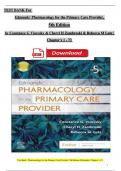TEST BANK For
Edmunds' Pharmacology for the Primary Care Provider,
5th Edition
by Constance G Visovsky & Cheryl H Zambroski & Rebecca M Lutz |
Chapter's 1 - 73
Test Bank - Pharmacology for the Primary Care Provider, 5th Edition (Edmunds), Chapter 1-73
1
,Test Bank - Pharmacology for the Primary Care Provider, 5th Edition (Edmunds), Chapter 1-73
2
,Test Bank - Pharmacology for the Primary Care Provider, 5th Edition (Edmunds), Chapter 1-73
3
,Test Bank - Pharmacology for the Primary Care Provider, 5th Edition (Edmunds), Chapter 1-73
4
,Chapter 01: Prescriptive Authority and Role Implementation: Tradition vs. Change
Test Bank
MULTIPLE CHOICE
1. Which of the following has influenced an emphasis on primary care education in medical
schools?
a. Changes in Medicare reimbursement
methods recommended in 1992
b. Competition from nonphysicians desiring
to meet primary care shortages
c. The need for monopolistic control in the
marketplace of primary outpatient care
d. The recognition that nonphysicians have
variable success providing primary care
ANSWER: A
The Physician Payment Review Commission in 1992 directly increased financial
reimbursement to clinicians who provide primary care. Coupled with a shortage of
primary care providers, this incentive led medical schools to place greater emphasis on
preparing primary care physicians. Competition from nonphysicians increased
coincidentally as professionals from other disciplines stepped up to meet the needs.
Nonphysicians have had increasing success at providing primary care and have been
shown to be safe and effective.
DIF: Cognitive Level: Remembering (Knowledge) REF: 2
2. Which of the following statements is true about the prescribing practices of physicians?
a. Older physicians tend to prescribe more
appropriate medications than younger
physicians.
b. Antibiotic medications remain in the top
five classifications of medications
prescribed.
c. Most physicians rely on a “therapeutic
armamentarium” that consists of less than
100 drug preparations per physician.
d. The dominant form of drug information
used by primary care physicians continues
to be that provided by pharmaceutical
companies.
ANSWER: D
Even though most physicians claim to place little weight on drug advertisements,
Test Bank - Pharmacology for the Primary Care Provider, 5th Edition (Edmunds), Chapter 1-73
5
, pharmaceutical representatives, and patient preference and state that they rely on
academic sources for drug information, a study showed that commercial rather than
scientific sources of drug information dominated their drug information materials.
Younger physicians tend to prescribe fewer and more appropriate drugs. Antibiotics have
dropped out of the top five classifications of drugs prescribed. Most physicians have a
therapeutic armamentarium of about 144 drugs.
DIF: Cognitive Level: Remembering (Knowledge) REF: 3
3. As primary care nurse practitioners (NPs) continue to develop their role as prescribers of
medications, it will be important to:
a. attain the same level of expertise as
physicians who currently prescribe
medications.
b. learn from the experiences of physicians
and develop expertise based on evidence-
based practice.
c. maintain collaborative and supervisorial
relationships with physicians who will
oversee prescribing practices.
d. develop relationships with pharmaceutical
representatives to learn about new
medications as they are developed.
ANSWER: B
As nonphysicians develop the roles associated with prescriptive authority, it will be
important to learn from the past experiences of physicians and to develop prescribing
practices based on evidence-based medicine. It is hoped that all prescribers, including
physicians and nurse practitioners, will strive to do better than in the past. NPs should
work toward prescriptive authority and for practice that is not supervised by another
professional. Pharmaceutical representatives provide information that carries some bias.
Academic sources are better.
DIF: Cognitive Level: Applying (Application) REF: 4
Chapter 02: Historical Review of Prescriptive Authority: The Role of Nurses (NPs,
CNMs, CRNAs, and CNSs) and Physician Assistants
Test Bank
MULTIPLE CHOICE
1. A primary care NP will begin practicing in a state in which the governor has opted out of
the federal facility reimbursement requirement. The NP should be aware that this defines
how NPs may write prescriptions:
Test Bank - Pharmacology for the Primary Care Provider, 5th Edition (Edmunds), Chapter 1-73
6
, a. without physician supervision in private
practice.
b. as CRNAs without physician supervision
in a hospital setting.
c. in any situation but will not be reimbursed
for this by government insurers.
d. only with physician supervision in both
private practice and a hospital setting.
ANSWER: B
In 2001, the Centers for Medicare and Medicaid Services changed the federal physician
supervision rule for CRNAs to allow state governors to opt out, allowing CRNAs to write
prescriptions and dispense drugs without physician supervision.
DIF: Cognitive Level: Understanding (Comprehension) REF: 9
2. CRNAs in most states:
a. must have a Drug Enforcement
Administration (DEA) number to practice.
b. must have prescriptive authority to
practice.
c. order and administer controlled substances
but do not have full prescriptive authority.
d. administer medications, including
controlled substances, under direct
physician supervision.
ANSWER: C
Only five states grant independent prescriptive authority to CRNAs. CRNAs do not
require prescriptive authority because they dispense a drug immediately to a patient and
do not prescribe. Without prescriptive authority, they do not need a DEA number.
DIF: Cognitive Level: Understanding (Comprehension) REF: 9
3. A CNM:
a. may treat only women.
b. has prescriptive authority in all 50 states.
c. may administer only drugs used during
labor and delivery.
d. may practice only in birthing centers and
home birth settings.
ANSWER: B
Test Bank - Pharmacology for the Primary Care Provider, 5th Edition (Edmunds), Chapter 1-73
7
, CNMs have prescriptive authority in all 50 states. They may treat partners of women for
sexually transmitted diseases. They have full prescriptive authority and are not limited to
drugs used during childbirth. They practice in many other types of settings.
DIF: Cognitive Level: Remembering (Knowledge) REF: 9
4. In every state, prescriptive authority for NPs includes the ability to write prescriptions:
a. for controlled substances.
b. for specified classifications of
medications.
c. without physician-mandated involvement.
d. with full, independent prescriptive
authority.
ANSWER: B
All states now have some degree of prescriptive authority granted to NPs, but not all
states allow authority to prescribe controlled substances. Many states still require some
degree of physician involvement with certain types of drugs.
DIF: Cognitive Level: Understanding (Comprehension) REF: 12
5. The current trend toward transitioning NP programs to the doctoral level will mean that:
a. NPs licensed in one state may practice in
other states.
b. full prescriptive authority will be granted
to all NPs with doctoral degrees.
c. NPs will be better prepared to meet
emerging health care needs of patients.
d. requirements for physician supervision of
NPs will be removed in all states.
ANSWER: C
The American Association of Colleges of Nursing has recommended transitioning
graduate level NP programs to the doctoral level as a response to changes in health care
delivery and emerging health care needs. NPs with doctoral degrees will not necessarily
have full prescriptive authority or be freed from requirements about physician
supervision because those are subject to individual state laws. NPs will still be required to
meet licensure requirements of each state.
DIF: Cognitive Level: Understanding (Comprehension) REF: 12
6. An important difference between physician assistants (PAs) and NPs is PAs:
a. always work under physician supervision.
b. are not required to follow drug treatment
Test Bank - Pharmacology for the Primary Care Provider, 5th Edition (Edmunds), Chapter 1-73
8
, protocols.
c. may write for all drug categories with
physician co-signatures.
d. have both inpatient and outpatient
independent prescriptive authority.
ANSWER: A
PAs commonly have co-signature requirements and work under physician supervision.
DIF: Cognitive Level: Understanding (Comprehension) REF: 17
Chapter 03: General Pharmacokinetic and Pharmacodynamic Principles
Test Bank
MULTIPLE CHOICE
1. A primary care nurse practitioner (NP) prescribes a drug to an 80-year-old African-
American woman. When selecting a drug and determining the correct dose, the NP
should understand that the knowledge of how age, race, and gender may affect drug
excretion is based on an understanding of:
a. bioavailability.
b. pharmacokinetics.
c. pharmacodynamics.
d. anatomy and physiology.
ANSWER: B
Pharmacokinetics is the study of the action of drugs in the body and may be thought of as
what the body does to the drug. Factors such as age, race, and gender may change the
way the body acts to metabolize and excrete a drug. Bioavailability refers to the amount
of drug available at the site of action. Pharmacodynamics is the study of the effects of
drugs on the body. Anatomy and physiology is a basic understanding of how the body
functions.
DIF: Cognitive Level: Understanding (Comprehension) REF: 21
2. A patient asks the primary care NP which medication to use for mild to moderate pain.
The NP should recommend:
a. APAP.
b. Tylenol.
c. acetaminophen.
d. any over-the-counter pain product.
ANSWER: C
Providers should use generic drug names when prescribing drugs or recommending them
Test Bank - Pharmacology for the Primary Care Provider, 5th Edition (Edmunds), Chapter 1-73
9





